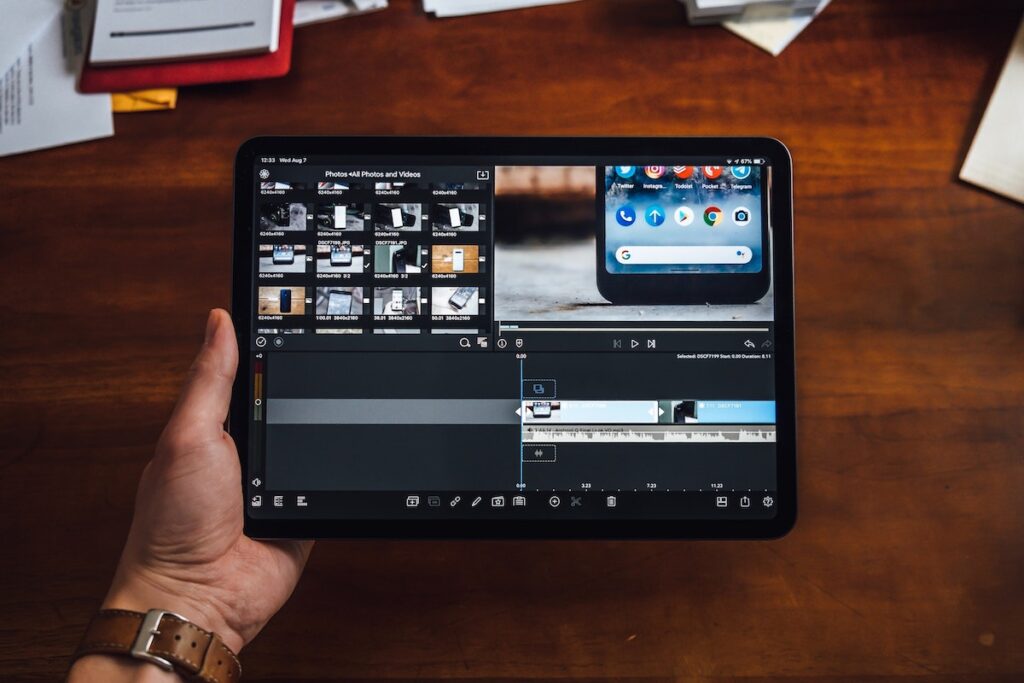Think about ALL of the digital products that you use: Spotify, Netflix, your web browser, and all those apps on your phone. Think about the function each one serves in your life. Then, think about the problems or inconveniences you’d run into if you didn’t have these digital products.
That’s where UI product designers start. They identify problems or gaps in offerings that exist in the digital landscape, then develop an app or other user interface to fill those gaps or solve those problems.
Developing a new digital product is a complex process that involves many different disciplines to craft the best user experience and overall final offering. Product designers are at the helm, which means they need to have a solid understanding of everything that goes into that process, from creating wireframes to branding and marketing.
VIVE LE DIFFERENCE: UX DESIGN + PRODUCT DESIGN
UX design refers to any interaction a person has with a product or service; it considers each and every component that shapes a person’s interaction with a product or service, encompassing a wide array of experience: from how it makes a user feel to how simple it is for a user to accomplish their desired task to how the product feels in their hands to how easy it is to complete a transaction (particularly online).
Product designers zoom out a bit more and focus on the product as a whole and the context in which it is being built and released. They look at how the final design will exist in the wild, considering business objectives, the overall market, competitors, and profitability. Product designers lead the team, keeping the big picture in mind while also ensuring all details are in place. UX designers primarily serve the user, while product designers serve both the users and the company.
WHAT DOES A UI PRODUCT DESIGNER DO?
Product designers contribute to a product in pretty much every phase of development — from conception to the product launch, to adapting the design to keep up with trends and usage patterns.
User Research
The research phase is where user needs, pain points, behaviors, and goals are mapped — it’s also where a deep understanding of the competitive landscape, industry standards, technical barriers, and opportunities are charted.
Design Thinking & UI
Companies are rapidly adopting the design thinking approach to developing products — centering the user experience by creating a deep understanding of the target user. The design thinking process opens up the opportunity for creativity and innovative approaches to users’ problems. Decisions are made about colors, fonts, motion, animation, and all other UI components that take into account both function and aesthetics. According to the aesthetic-usability effect, it’s vital to have aesthetically-pleasing UI because interfaces with stellar aesthetics are recognized as more “usable” by users.
Prototyping
One of the most effective ways to test out new products, prototyping offers an opportunity to interact with the product, identify problems, and brainstorm solutions. Product designers manage this process and are integral in taking the prototype to the next step by asking the right questions to find avenues to improve the UX.
Business Strategizing
At the end of the day, this product has to go to market. What’s that going to look like? How can it be most successful? How can the company create the best product while also being cost-effective? The product designer has to take all of this into account in their decision making. The UX Collective sums it up like this:
“Design will not be just about users. It will also be about the business. As Product Designers, we must drive product solutions that service the goals of both the users and the company.”
Branding & Marketing
Product designers work closely with the marketing team to ensure the product being developed is identical to the one being advertised. Good marketing helps sell a product; a good product keeps customers coming back. Advertising that overstates and exaggerates functions that the product can’t deliver will steamroll public trust in a brand. The product designer is critical in making sure these elements are in alignment.
Testing & Adapting Design
Testing ensures that the choices made during the design phase stand up to scrutiny and is when user difficulties that were not discernible during design have a chance to be addressed. Other details also have an opportunity to be refined. There are numerous testing methods commonly used, including A/B testing, usability testing, and remote user testing.
The end product, over time, will be evaluated and re-evaluated using the same criteria to ensure that what the business is offering provides the desired experience and solution that the end-user wants. Continuing this cycle of testing ensures the product designer has essential information to keep the design relevant — aligned to changes in the market, user patterns, trends, and technology — all of which keeps the product meaningful to its audience.
In short, a UI product designer has an extensive range of responsibilities and connects many different departments to make their vision of the product come to life.
YOU NEED THESE ATTRIBUTES AND CHARACTERISTICS TO SUCCEED AT BEING A UI PRODUCT DESIGNER
A diverse set of skills is needed to build a career as a UI product designer. Yes, you need to be comfortable navigating user research, visualizing user journeys, and other UI-specific processes and technical skills — but the role includes making a lot of high-level strategic decisions, so interpersonal, communication, and people management skills.
Product designers take large concepts and abstract ideas and turn them into actionable directions for the development team. A strong understanding of how businesses work and an interest in tracking market trends are vital — but the most essential trait of all for a UI product designer is an avid interest in finding problems and working with a team to solve them.
QUALIFICATIONS
As well as having a well-rounded design background with experience solving complex and challenging problems, companies want candidates who can lead a team, are business-minded, and will be a good culture add.
Communication skills are critical, as is fluency in design programs like the Adobe Creative Suite (XD in particular), Sketch, Figma, and Framer. Companies want to see your wealth of experience and a diverse group of projects in your portfolio to see how you solve problems and a sense of your visual and aesthetic language. Demonstrating that you have a user-centric approach to solving problems via user research and testing will help set you apart in an interview.
If you want to learn more about UI product design to see if a career in this growing field might be right for you, check this out.
SALARY
The average salary for a product designer varies by experience, sector, and location. Product designers typically make between $50k – $128k. In 2020, the average salary in the US was $82,583 based on data provided by Glassdoor, Indeed, and PayScale.
About the author.
An award-winning creator and digital health, wellness, and lifestyle content strategist — Karina writes, edits, and produces compelling content across multiple platforms — including articles, video, interactive tools, and documentary film. Her work has been featured on MSN Lifestyle, Apartment Therapy, Goop, Psycom, Pregnancy & Newborn, Eat This Not That, thirdAGE, and Remedy Health Media digital properties.




